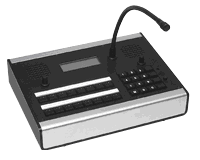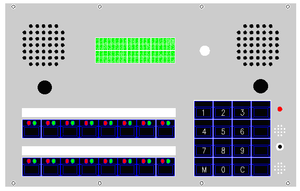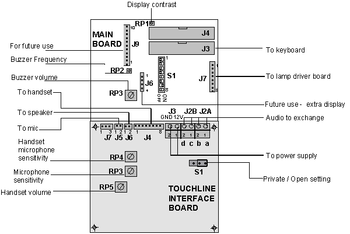MCS station: Difference between revisions
From Zenitel Wiki
| Line 168: | Line 168: | ||
===Switches and Connectors=== | ===Switches and Connectors=== | ||
[[Image:MCS-4-8.PNG | [[Image:MCS-4-8.PNG|350px|Main Board and TouchLine Interface Board]] | ||
[[Category:Stations]] | [[Category:Stations]] | ||
Revision as of 09:30, 5 February 2009
Features
Special Control Room Station Features
The Control Room Stations are designed to provide good control and easy operation in situations where many calls are directed to one central point, for monitoring and talking into conferences and monitoring of other activities in the system:
- Access to more than 10 Single-touch keys on one station for quick and easy handling of calls to and from a large number of stations/features.
- - 20 Single-touch keys on an MCS station
- Call priorities shown by display, LED and buzzer indication (programmable).
- Noise-canceling goose-neck microphone
- Headset option.
Multiconference Features
- Mixing of audio from up to six simplex conferences in one loudspeaker.
- Easy programming of control keys for the multiconference features, like TalkBack key and Activate key.
- Special Multiconference station MCS with two loudspeakers for mixing of audio and 20 single-touch keys giving enhanced control when using the Multiconference features.
Note that any station with display and single-touch keys can be used but with a somewhat reduced function pattern compared to the MCS station.
System Features Useful on a Control Room Station
- Display information giving names and numbers of call-in points.
- Programmable function keys for station transfer, program selection, etc.
- Parallel service provides flexibility in manning of control stations.
- Off-hook time-out. The station goes on-hook and becomes free after 25 seconds (programmable) when not in conversation.
- Line monitoring provides automatic checking of stations’ lines, reporting to the control room station as well as to a central service point (programmable) on line failure.
Number of MCS Stations in One Exchange
- The MCS station can be connected to any type of AlphaCom exchanges. The maximum number of MCS stations in one exchange is set to 25, considering system load due to LED updates on all stations simultaneously.
Additional Information: MCS can not be used with TouchLine or TouchLine Compact exchanges.
Feature Description
Calling a station
When the single-touch (DAK) keys have been programmed, you just press the key to activate the call or feature programmed on the station. To cancel the call, press the C-key. If you hold down the key, it works as an M-key. When it is released, the M-key state is terminated, and the ordinary M-key must be used later during the conversation.
Additional Information: The M-key/C-key function for the single-touch keys is intended for announcements: Press the key, keep it down while speaking and release it to cancel.
Simplex Conference
A simplex conference has one speaker and many listeners. There is no upper limit; all stations in an exchange can be members of one conference and thus listen to the same source. This concept is also called program conference, as it uses the same hardware as audio program distribution. You can speak into the conference from one station at a time simply by pressing the M-key while listening to a conference. To interface e.g. to mobile radio systems, each conference can have a default member, which also can be default speaker. The default member is forced into conference when the first normal member joins. If it’s the default speaker, it will feed the conference without any active use of M-key. When a normal member uses it’s M-key, the conference is fed temporarily from that station, but returns to the default speaker after the M-key has been released again. The AlphaCom has 50 simplex conferences. One station can be member of one conference at a time. A station can join the conference by dialing 82xx, or one or more stations can have access to remote setup to station/group by dialing 75 + station/group + 82xx. A station leaves a conference by dialing 8200.
Simplex Multiconference
A single station can be member of many Simplex Conferences at the same time. To be able to use the full functionality, a dedicated MCS station is required. It has two speakers; each can be a mix of up to 6 conferences. In addition, it has a dedicated single-keyboard with 20 Single-touch (DAK) keys that can be programmed with the special keys used to control the multiconference features. The MCS station is basically a standard intercom station, i.e. in addition to the multiconference feature, full AlphaCom functionality is available. Note that any station with display and single-touch keys can be used for the Multiconference feature but with a somewhat reduced function pattern compared to the MCS station.
Single-touch Keys for Multiconference Control
Before you can use the station, you must program the keys Select (SEL), Activate (ACT), Priority (PRI) and the off key.
- TalkBack
- This key is used when you want to talk into the conferences. As many conferences are monitored at the same time, each conference has its own TalkBack key. During commissioning you link an AGA board/port to the station’s TalkBack keys.
- SELect
- The Select key is used when you assign a conference to a TalkBack key. Select modifies the TalkBack key’s conference parameter.
- ACTivate
- This key is used when you activate monitoring of a conference. When the TalkBack key is pressed, this station goes in or out of the corresponding simplex conference depending on the previous state. Audio is controlled immediately on/off. Several TalkBack keys can be pressed during one Activate session, which is terminated by another press of the Activate key.
- PRIority
- The Priority key is a variant of activate and one channel is forced active, all others off.
- OFF
- The DeActivateAll is a variant of activate and all channels are switched off.
Station Description
The Multiconference Station MCS
Station Controls
The station is equipped with:
- 16 single-touch keys each with a green and a red LED.
- 4 single-touch keys without LEDs.
- Two loudspeakers, each can mix the audio of 6 simplex conferences.
- The speakers are 45-ohm speakers.
- External loudspeakers may be added, minimum 8 ohm.
- 2 Volume adjustment potentiometers, one for each loudspeaker.
- LCD display with backlight.
- The LCD display has 4 lines with 20 characters on each.
- 0-9 digit keypad.
- M-key for manual control of speech direction.
- C-key for canceling calls.
- Noise-canceling gooseneck microphone.
- Microphone LED.
- Buzzer.
- Relay output (for external buzzer or general RCO).
The building blocks
The Multiconference Station (MCS) is presented to the user as an integrated exchange feature, but it actually consist of several independent parts. You should understand the properties of the different building blocks, as it will make configuration easier, and will also allow you to see possible variant applications.
- MCS station. Other station types with display and single-touch keys can also be used, but the MCS station is designed to use all control possibilities for a multiconference.
- AGA board. The exchange must be equipped with minimum one AGA board to use the Multiconference features. The ports on the AGA board used for connection to MCS are set in conference mode.
- Software features. You must have AMC software 07.60 or later to use the Multiconference features.
Configuration Guidelines MCS
MCS stations per AGA board:
- When using the multiprogram connection board:
- 4 MCS stations per AGA board.
- When using ASLT cables and connection board:
- 3 MCS stations per AGA board.
AGA boards in MCS mode
There can be a maximum of 24 AGA boards in one AlphaCom 138 exchange, corresponding to 96 (72) MCS stations. These must be in the master module of a multi-module exchange.
Remember that in a high traffic multi-module exchange you will need 3 AGA positions for the multi-module audio ring (24 channels), possibly 1-2 AGAs for audio program (22-38 programs), and 1-2 AGAs if AlphaNet is used.
Max simplex conferences in one module (master or slave): 50
Max simplex conferences when more than one module is involved: 24
Feeding 50 conferences into the master module can be tricky, especially if you need many MCS AGAs which block ASLT positions. 50 conferences correspond to 9 ASLT boards. You can get 24 conferences in from slave modules. On top of this you must consider where the MCS station’s abcd wire ASLT interface is located. They can be in a slave, but in that case TalkBack is limited to the 24 conferences in the multi-module ring.
MCS stations in one system
The maximum number of MCS stations in one exchange is set to 25, considering system load due to green LED updates on all stations simultaneously.
This is not an absolute figure. The limitation is due to the large number of display data messages that must be sent when audio comes and goes, as worst-case all MCS stations monitor the same channel. The processing will delay other exchange operations, so that response to dialing becomes noticeable slow, tones long, etc.
AlphaNet
A large system may be running each module as a standalone exchange, connected to the others via AlphaNet. This increases the number of master modules available, and the MCS stations may be divided among the exchanges, thus reducing system load. Such a setup also gives some redundancy, as one failing exchange will take out only some of the MCS stations. Use of AlphaNet may require special interfaces to radios etc. to feed several exchanges in parallel.
Software: AMC 08.00 and later to have Multiconferences in AlphaNet.
Installation
Multiconference Station MCS
The MCS is a semi-intelligent station that is controlled completely by the AlphaCom exchange. All configuration of single-touch keys is stored inside the processor board AMC in the exchange, and the display and LEDs in the DAKs are controlled from the AMC via display data on the station’s ab wires.
Equipment Overview
Use this list to check that you have received the correct modules:
| Equipment | Item Number | Comments |
|---|---|---|
| MCS Multiconference Station with gooseneck micrphone | 100 7006 201 | Mandatory |
| Desktop housing for MCS with cable set. | 100 7006 280 | Optionally, the station cen be flush mounted in any type of control room desk |
| Headset | no supplied by Stentofon | Can be used in stead of a handset |
| Local power supply for the station | EQPOW 20490 | Local Power is mandatory. For example: Mascot 6823 - 220V/12V DC, 1 Amp |
| Upgrade kit for AMC software | 100 9290 001 | To latest version |
| Upgrade kit for AlphaPro software | 100 9291 110 | To latest version |
Hardware and Software Requirements MCS
- AMC-board with AMC SW 07.60 or later.
- Multiconference Station; see the Equipment Overview above.
- AlphaPro programming tool, 1009291100 version 07.20 or later.
- Local +12V DC / 700 mA power supply for the station. (If ordering from Stentofon: EQPOW 20490 Mascot Power 6823/6-12).
- Station cable must be supplied locally. The cable is connected to the Main Module with screw connectors.
Circuit Boards
The MCS station is in general a mechanic variant of the station type CRM IV Control Room Master. The Main Board and the TouchLine Interface Board are identical to the ones used in the CRM IV station. The station has four circuit boards:
- The Main board controlling the station software.
- The TouchLine Interface board holding the electronics for the audio control and audio interface to the exchange.
- The Main Keyboard holding the electronics for the keys.
- The Audio board with special features for the MCS station.




